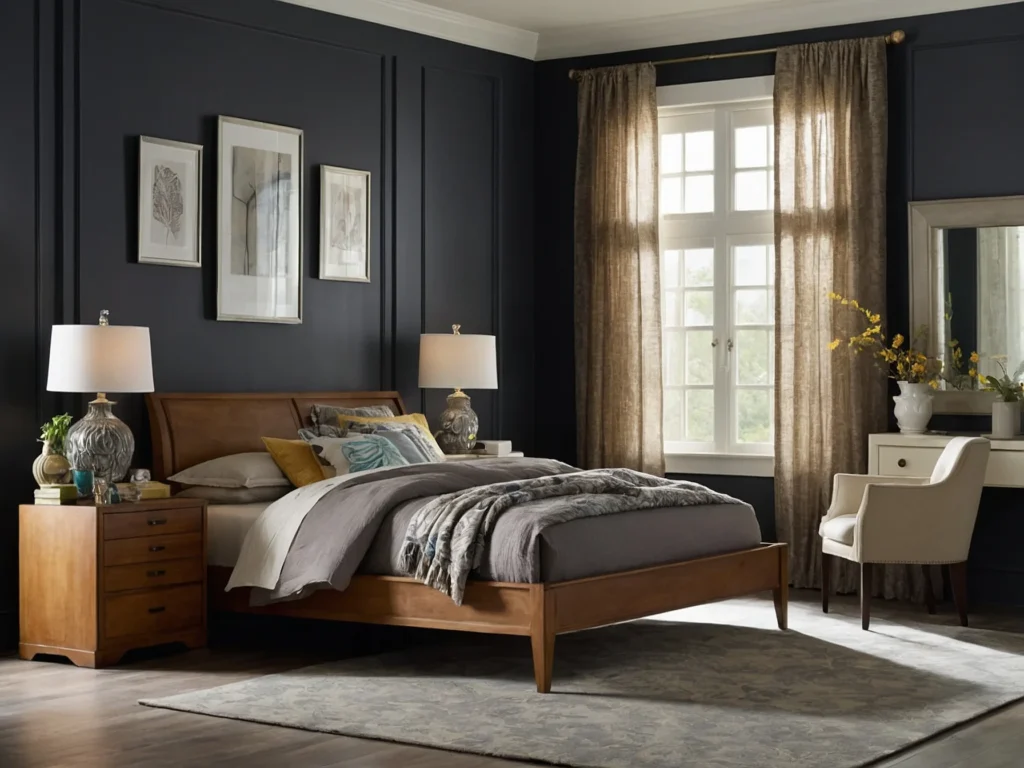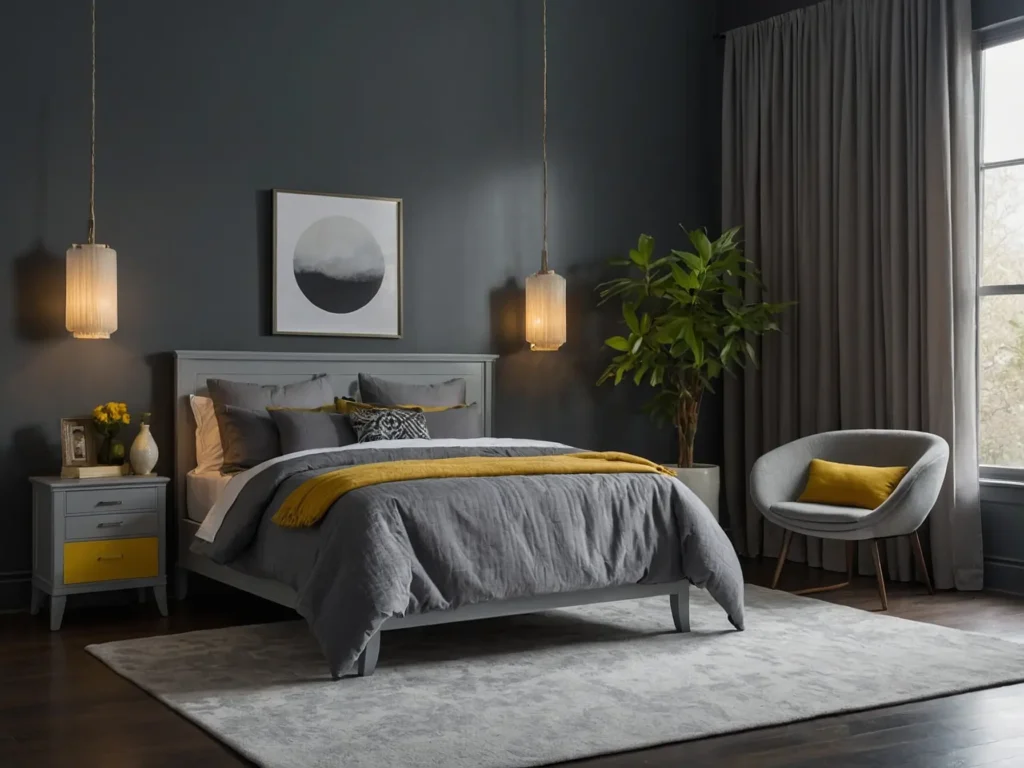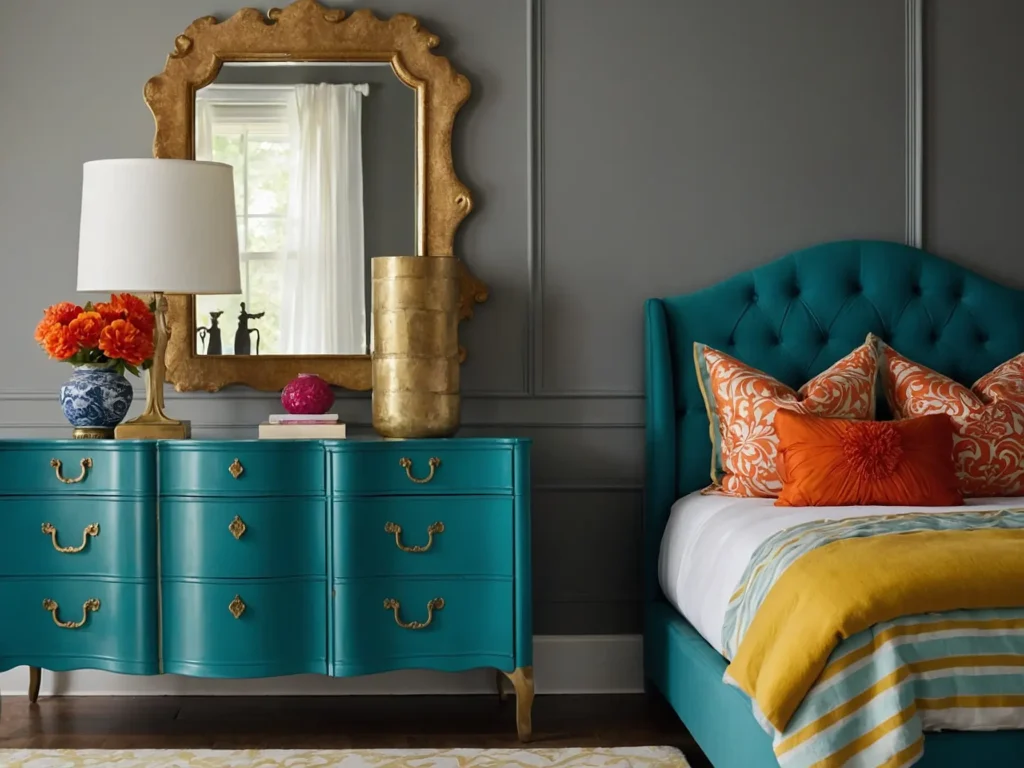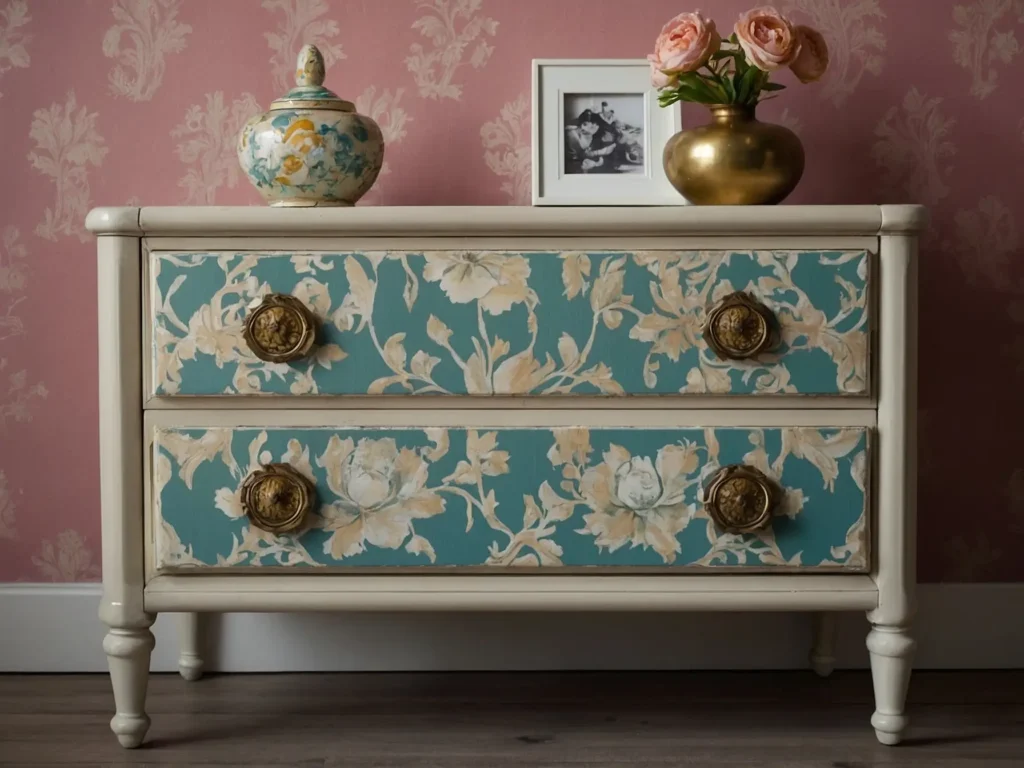The bedroom is more than just a place to sleep; it’s a sanctuary, a personal space that reflects your style and personality. And what better way to infuse your individuality into this space than by giving your furniture a fresh coat of paint? Whether it’s a worn-out dresser, a dull nightstand, or a mundane bed frame, painting bedroom furniture can breathe new life into your surroundings.

Benefits of a Makeover
- Transformation: Painting bedroom furniture is about more than just changing the color. It’s about transformation and creativity. With the right techniques and color choices, you can turn an ordinary piece of furniture into a work of art.
- Cost-Effective: Instead of buying new furniture, why not revamp what you already have? A DIY project like this can save you money while giving your room a fresh look.
- Personal Touch: You make the furniture uniquely yours by choosing the colors and techniques. It’s a chance to express yourself and create something no one else has.
- Environmentally Friendly: Painting and repurposing furniture is a great way to reduce waste. It’s a sustainable choice that’s good for the planet.
Current Trends in Bedroom Furniture Painting
- Bold Colors: Bold colors are from vibrant blues to rich reds. They add energy and excitement to the room.
- Metallic Finishes: Gold, silver, or copper finishes can add a touch of elegance and sophistication.
- Distressed Look: The distressed look is popular for a rustic or vintage feel. It adds character and charm to the furniture.
- Geometric Patterns: If you’re looking for something modern and edgy, geometric patterns are the way to go. They add visual interest and a contemporary touch.
Types of Paint
When painting bedroom furniture, selecting the right type of paint is crucial. The paint you choose will determine the finish’s appearance, durability, and quality. Here’s a guide to help you navigate through the various options:
Latex Paint
- Quality and Durability: Latex paint is known for its ease of use and durability. It dries quickly and provides a smooth finish.
- Best for: Ideal for most bedroom furniture, especially if you’re looking for a wide range of color options.
- Considerations: Make sure to use a primer if painting over a previously finished surface.
Milk Paint
- Quality and Durability: Milk paint offers a unique, matte finish that can give your furniture a vintage or rustic look.
- Best for: Perfect for those who prefer an eco-friendly option, as it’s made from natural ingredients.
- Considerations: It may require a bonding agent if used on non-porous surfaces.
Eggshell Paint
- Quality and Durability: Eggshell paint has a soft, velvety finish that’s slightly more lustrous than matte. It’s easy to clean and resists scuffs.
- Best for: Suitable for bedroom furniture that requires a subtle sheen without being too glossy.
- Considerations: It’s essential to prepare the surface properly to ensure the best adhesion.
Limewash Paint
- Quality and Durability: Limewash paint creates a textured, weathered look and is known for its breathability and mold resistance.
- Best for: Great for creating a unique, antique effect on wooden furniture.
- Considerations: It requires a specific application technique, so it might be best for those with some painting experience.
Tools and Techniques
Painting bedroom furniture is an exciting project that allows you to express your creativity. However, the right tools and techniques are essential to achieve a professional-looking finish. Here’s a guide to help you get started:
Paint Brushes
- Use for: Detail work, corners, and small surfaces.
- Types: Choose natural bristle brushes for oil-based paints and synthetic brushes for water-based paints like latex.
- Technique: Use gentle, even strokes for a smooth finish.
Paint Rollers
- Use for: Large, flat surfaces.
- Types: Foam rollers are great for a smooth finish, while textured rollers can create interesting effects.
- Technique: Roll in a “W” pattern for even coverage.
Paint Sprayers
- Use for: Quick and uniform coverage, especially on intricate or detailed pieces.
- Types: Airless sprayers are popular for furniture, while HVLP (High Volume, Low Pressure) sprayers offer more control.
- Technique: Keep the sprayer consistently from the surface and move in smooth, horizontal strokes.
Latex Paint Sprayer
- Use for: Specifically designed for latex paint, offering a flawless finish.
- Technique: Similar to other sprayers but may require specific paint thinning.
Furniture Wax
- Use for: Sealing and protecting the paint, adding a soft sheen.
- Technique: Apply with a soft cloth or brush, following the wood grain, and buff to the desired shine.
Additional Techniques for Painting Old Furniture
- Sanding: Prep the surface by sanding to remove old paint or varnish. It helps the new paint adhere better.
- Priming: Use a primer if you paint over dark or stained wood. It ensures a uniform color.
- Distressing: For a vintage look, lightly sand the edges after painting.
- Sealing: A clear sealer or varnish will protect your painted furniture and enhance its durability.
Preparing the Furniture
Properly preparing bedroom furniture is essential before diving into the exciting world of painting. This step ensures the paint adheres well and lasts longer, giving your furniture a stunning makeover. Here’s a step-by-step guide to getting your wood furniture ready for painting:
1. Cleaning
- Why: Removes dust, grime, and any residues that might interfere with the paint.
- How: Use a mild detergent and water or a specialized wood cleaner. Rinse well and allow to dry.
2. Sanding
- Why: It creates a smooth surface and helps the paint adhere better.
- How: Use fine-grit sandpaper and sand toward the wood grain. Consider using a liquid sanding agent to paint bedroom furniture without sanding.
- Considerations: A sanding sponge can be more effective for pieces with intricate details.
3. Removing Old Stains and Wax
- Why: Ensures a uniform finish and prevents discoloration.
- How: Use a stain remover or wax stripper following the manufacturer’s instructions.
4. Priming
- Why: It provides a base for the paint, especially if you’re changing from a dark to a light color.
- How: Apply a coat of primer suitable for wood furniture. Allow to dry as per the instructions.
5. Repairing Damages
- Why: It fixes any imperfections that might show through the paint.
- How: Fill any holes or cracks with wood filler and sand smooth.
Step-by-Step Painting Guide
Painting bedroom furniture is a rewarding DIY project that allows you to transform your space with creativity and flair. Whether you’re painting bedroom furniture black for a sleek modern look, going grey for a chic neutral tone, or experimenting with chalk paint for a vintage charm, here’s a step-by-step guide to help you achieve the perfect painted wooden furniture makeover:
1. Choose Your Paint and Tools
- What: Select the type of paint and tools based on your desired finish. Chalk paint is great for a rustic look, while latex or acrylic offers a smooth finish.
- Tip: Don’t forget to pick up a good-quality brush or roller for a streak-free application.
2. Prepare the Surface
- What: Follow the preparation steps from Subsection 1, including cleaning, sanding, and priming.
- Tip: If you’re going for a distressed look, you might skip the priming.
3. Apply the First Coat
- What: Apply the paint in thin, even strokes, or use a sprayer for uniform coverage.
- Tip: Allow the paint to dry completely before assessing if a second coat is needed.
4. Apply Additional Coats if Needed
- What: Depending on the color and finish, you might need a second or third coat.
- Tip: Sand lightly between coats for a super-smooth finish.
5. Add Decorative Effects (Optional)
- What: Experiment with techniques like stenciling, distressing, or glazing for a unique look.
- Tip: Practice on a scrap piece of wood first to perfect your technique.
6. Seal the Paint
- What: Apply a clear sealer or wax to protect the paint and add durability.
- Tip: Choose a matte or glossy finish based on your preference.
7. Reassemble and Admire
- What: If you’ve removed hardware or disassembled the furniture, put it back together.
- Tip: Take a moment to admire your handiwork. You’ve just created a beautiful piece of painted furniture!
Creative Ideas and Inspiration
Painting bedroom furniture is not just about changing colors; it’s an opportunity to infuse your space with personality, whimsy, and artistry. From bold color schemes to intricate designs, the possibilities are endless. Here are some creative and whimsical painted furniture ideas to spark your imagination:
1. Whimsical Painted Furniture

- What: Think of fairytale charm, playful patterns, and unexpected color combinations.
- How: Use stencils to create floral designs or freehand a whimsical scene. Pastel colors often work well for this style.
- Inspiration: Imagine a dresser with delicate vines and flowers or a nightstand adorned with playful birds.
2. Bedroom Grey Furniture Paint Ideas

- What: Grey is versatile and sophisticated. It can be cool and modern or warm and rustic.
- How: Pair different shades of grey with contrasting colors like yellow or teal for a striking effect.
- Inspiration: Consider a grey ombre effect on a tall dresser, transitioning from dark to light.
3. Bedroom Furniture Chalk Paint Ideas

- What: Chalk paint offers a matte finish perfect for a vintage or shabby chic look.
- How: Use chalk paint for distressing techniques or to create a soft, romantic feel.
- Inspiration: A chalk-painted bed frame with lightly distressed edges can add a cozy, farmhouse touch.
4. Bold Color Schemes

- What: Don’t be afraid to go bold with vibrant colors that make a statement.
- How: Choose complementary colors or a monochromatic scheme with varying shades of the same color.
- Inspiration: A bright turquoise dresser with gold handles can be a stunning focal point.
5. Artistic Painted Furniture Pictures

- What: Turn your furniture into a canvas and paint a picture or scene.
- How: Sketch your design first, then fill it in with paint, or use a projector to trace an image.
- Inspiration: Imagine a bookshelf with a painted landscape across the shelves, turning it into art.
6. Mixed Media

- What: Combine paint with fabric, wallpaper, or decoupage.
- How: Add fabric to drawer fronts or decoupage images onto the sides.
- Inspiration: A nightstand with wallpapered drawers can add texture and interest.
Common Questions and Answers
When painting bedroom furniture, many questions might arise, especially if you’re new to DIY furniture transformation. Here’s a handy FAQ section to guide you through some common queries:
Can I Paint My Old Bedroom Furniture?
Absolutely! Painting old bedroom furniture is a fantastic way to give it a new lease on life. Whether it’s Victorian furniture or a simple wooden dresser, a fresh coat of paint can transform it into a beautiful piece that complements your space.
Should All the Bedroom Furniture Be Painted the Same Color?
While painting all the furniture the same color can create a cohesive look, it’s not a rule. Feel free to mix and match colors or use shades of the same color for a more dynamic effect. The key is to choose colors that harmonize with your overall bedroom theme.
What Paint to Use for Interior Furniture?
The choice of paint depends on the look you want to achieve and the type of furniture. Latex or acrylic paint is versatile and comes in various finishes. Chalk paint is great for a vintage look, while oil-based paint offers a durable finish. Consider the furniture’s use and the desired appearance when selecting paint.
What Colour Is Best for Bedroom Furniture?
The best color for bedroom furniture is subjective and depends on your taste and the room’s décor. Neutral shades like grey or beige are versatile, while bold colors like blue or red can add a pop of energy. Consider the mood you want to create and choose colors that resonate with you.
What Is the Most Popular Color for Bedroom Furniture?
Popular colors for bedroom furniture often include classic whites, elegant greys, and soothing blues. However, trends change, and what’s most important is choosing a color that you love and fits your style.
How to Paint Laminate Furniture?
Painting laminate furniture requires some extra preparation. Start by sanding the surface lightly to help the paint adhere. Use a good-quality primer designed for laminate, followed by a paint suitable for the surface, like latex or acrylic. Finish with a clear sealer for protection.
Can I Paint Antique Furniture?
Painted antique furniture can look stunning, but it’s essential to consider the piece’s value and history. If it’s a valuable antique, consult with a professional restorer first. If you decide to paint, use gentle techniques and quality materials to preserve the piece’s integrity.
Final Thoughts
Painting bedroom furniture is more than a home improvement task; it’s a journey of creativity, transformation, and personal expression. From the initial stages of preparation to the final brush strokes, each step is an opportunity to infuse your space with your unique style and personality.
Summary of Key Points
- Preparation: Proper cleaning, sanding, and priming are essential for a smooth and lasting finish.
- Paint and Tools Selection: Understanding the different types of paint and tools helps achieve the desired look, whether a sleek modern appearance or a rustic charm.
- Techniques: Mastering various painting techniques, from basic brush strokes to decorative effects, allows endless possibilities.
- Inspiration: Embrace creativity with whimsical designs, bold color schemes, or artistic touches that reflect your taste.
- Guidance: Addressing common questions and concerns ensures a successful project, whether painting Victorian furniture or a simple nightstand.
Encouragement for DIY Projects
If you’ve never painted furniture before, don’t be intimidated. You can transform your bedroom furniture into something beautiful with patience, practice, and a willingness to learn. The satisfaction of seeing the painted bedroom furniture before and after is well worth the effort.
Final Tips
- Experiment: Don’t be afraid to try new ideas or mix and match styles.
- Take Your Time: Good preparation and careful application produce a professional-looking finish.
- Enjoy the Process: Embrace the creativity and joy of a DIY project.
Inspiration and Creativity
Your bedroom is a sanctuary where you begin and end each day. Making it a reflection of you through painted furniture is rewarding and fulfilling. Whether it’s a complete bedroom makeover or a simple refresh, the power of paint is transformative.

